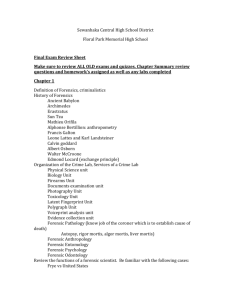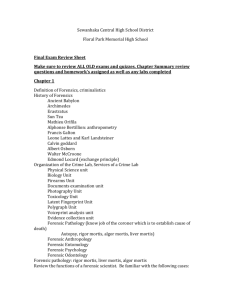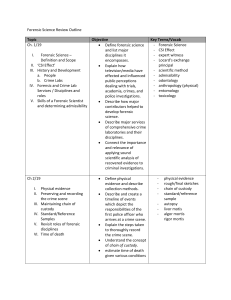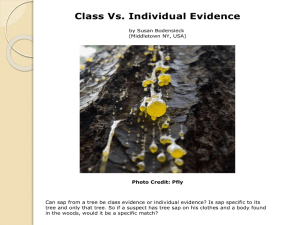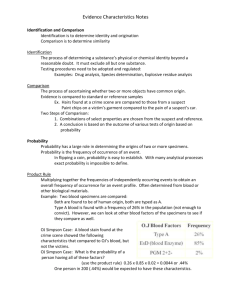Floral Park Memorial High School NAME: 2012/2013 Mrs Naus & Mr
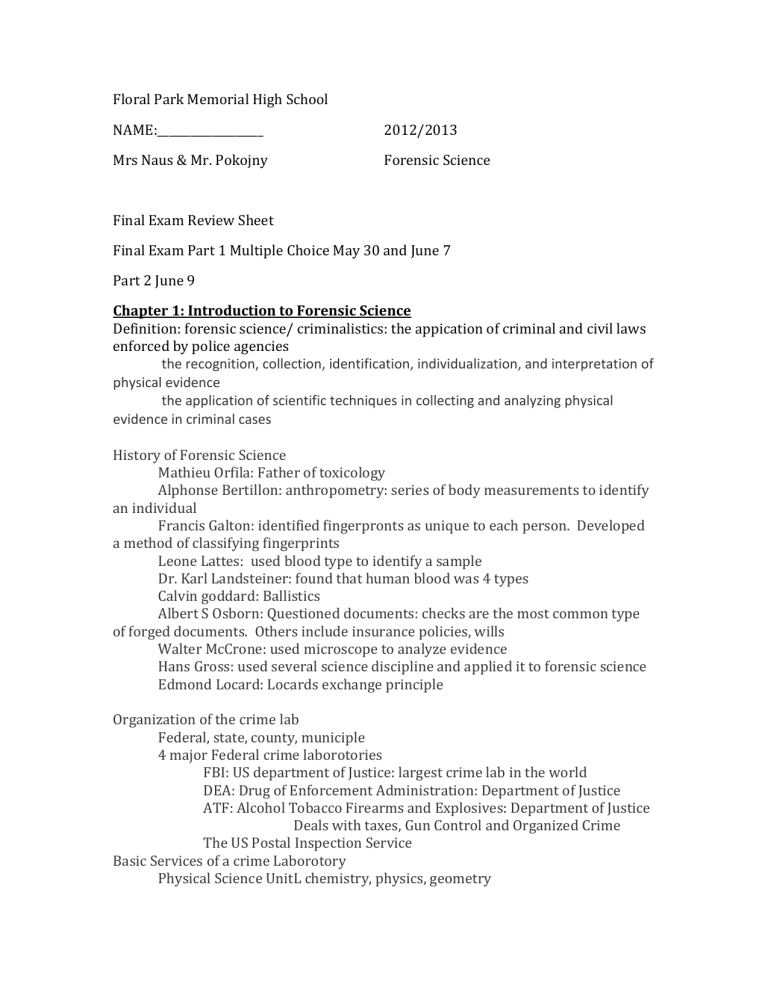
Floral Park Memorial High School
NAME:___________________
Mrs Naus & Mr. Pokojny
Final Exam Review Sheet
2012/2013
Forensic Science
Final Exam Part 1 Multiple Choice May 30 and June 7
Part 2 June 9
Chapter 1: Introduction to Forensic Science
Definition: forensic science/ criminalistics: the appication of criminal and civil laws enforced by police agencies
the recognition, collection, identification, individualization, and interpretation of physical evidence
the application of scientific techniques in collecting and analyzing physical evidence in criminal cases
History of Forensic Science
Mathieu Orfila: Father of toxicology
Alphonse Bertillon: anthropometry: series of body measurements to identify an individual
Francis Galton: identified fingerpronts as unique to each person. Developed a method of classifying fingerprints
Leone Lattes: used blood type to identify a sample
Dr. Karl Landsteiner: found that human blood was 4 types
Calvin goddard: Ballistics
Albert S Osborn: Questioned documents: checks are the most common type of forged documents. Others include insurance policies, wills
Walter McCrone: used microscope to analyze evidence
Hans Gross: used several science discipline and applied it to forensic science
Edmond Locard: Locards exchange principle
Organization of the crime lab
Federal, state, county, municiple
4 major Federal crime laborotories
FBI: US department of Justice: largest crime lab in the world
DEA: Drug of Enforcement Administration: Department of Justice
ATF: Alcohol Tobacco Firearms and Explosives: Department of Justice
Deals with taxes, Gun Control and Organized Crime
The US Postal Inspection Service
Basic Services of a crime Laborotory
Physical Science UnitL chemistry, physics, geometry
Biology Unit: DNA profiling, blood and body fluids, hairs, fibers, botanical material
Firearms Unit: firearms, discharged bullets, cartridges, shotgun shells, ammunition, gun shot residue
Document Examination unit: handwriting, typewriting, authenticity, paper, ink, indentated writings
Photography unit: digital imaging, infrared, UV and x-ray photography help visualize”invisible” evidence
Toxicology unit: drugs and poisons
Latent fingerprint unit: process and examine latent or invisible fingerprints
Polygraph Unit: lie detector: Galvanic skin respone
Voiceprint analysis unit: voiceprint: turns speech into a visuale graphic
Evidence Collection Unit: collect and preserve physical evidence
Job of a Forensic Scientist
Analysis of physical evidence as per the Frye Standard: create in 1923: a standard guideline for determining the admissibility of scientific evidence
Evidence must be generally accepted by the professional scientific community
Daubert vs Merrell Dow: : experts testimony rests on their professional knowledge of subject based on testing, peer review and publication, rate of error, standards tested against and acceptance in the scientific community
Expert testimony: must extablish to the judge that he or she possesses knowledge relevant to the trial that is not expected of the average human.
The judge rules on the witness;s professional qualifications.
The opposing attorney is allowed to cross examine to point out weakness in expertise
Collection, Preservation and recognition of physical evidence
Forensic scientists must be skilled
Inapplying priciples and techniques to the analysis of different types of evidence In order to provide expert testimony in court
Forensic Science Services
Forensic Pathology: investigation of sudden, unnatural unexplained or violent deaths
Medical examiner or the coroner or forensic pathologist: responsible for performing and autopsy
Rigor mortis: stiffening of body
Liver mortis: blood settling closest to ground
Algor mortis: reductio of body temperature
Forensic Anthropology: identification of human skeleton
Forensic Entomology: studies insects and larvae. Time of death can be estimated based on the stage of larval development ex: maggots
Forensic Psychology: relates human behavior to crime. Create profiles.
Determine if a suspect is mentally capable of withstanding trial
Forensic Odontology: identification of evidence based on teeth
Forensic engineer: accident analysis, reconstruction and cause of fire or explosion
Legal terms:
Corpus delicti: the principle that a crime must have been proven to have occurred before a person can be convicted of committing that crime.
Stare decisis: "the decisions remains" or words to that effect, It says that once a decision is made it becomes a precedent and the courts have a bias toward respecting and preserving that precedent. It is necessary to ensure that the law be predictable and consistent and not change every time a different judge or bench looks at an issue
Pro bono: work taken voluntarily.
Nolo contendere: refers to a pleas of no contest. An alternative to pleading guilty or not guilty.
Chater 2: The Crime Scene
Physical evidence: any and all evidence that can establish that a crime has been committed or link a suspect to a crime and or victim
Analysis of crime scene:
1Secure and Isolate the scene
2Record the scene a.
photography b.
sketching: rough sketch vs finished sketch CAD: computer aided draft c.
notes
3- Systematic search of crime scene a.
spiral search b.
grid method c.
strip or line search d.
quadrant or zone search
4- Collect and package evidence collection must make sure that there is not any change in the evidence through contamination, breakage, evaporation, accidental scratching or bending, loss or careless packaging each item is packaged separately ubreakable plastic bottles with pressure lids are used to package: hair glas, fiber and small trace evidence druggist fold: powders airtight containers: arson evidence to prevent evaporation porous container: blood stained articles: prevent mold growth prevents accumulation of moisture
5- Maintain chain of custody: list of all person who came in contact with evidence
Crime Safety
6- Obtain a standard or reference sample
7- submit evidence to lab
Latex gloves, mask or respirator, specific tools should be designated to prevent contamination during evidence collection, biohazard plastic bags, eating and drinking is prohibited
Warrentless searches
1emergency circumstances
2need to prevent immediate destruction
3search of a person and property prior to an arrest
4consent of the person
Chapter 3: Physical Evidence
Identification: determining what a substance is
Comparison: determining if two or more substances have the same origin
Individual evidence: has one single source
Class evidence: evidence associated with a group
Product rule: multiplies the frequency of independently occurring genetic markers to obtain a genetic profile.
Attempts to individualize evidence
Crime scene reconstruction: relies on combined evidence from medical examiner, law enforcement ad criminalists
Ex: laser beams used to determine the path of a bullet
Chapter 4: Glass and soil
Depending on the circumstance, glass evidence can be individualized: a piece that fits perfectly like a puzzle piece
Physical properties
Temperature,Weight, mass, density, refractive index
Crystalline solids: have definite shape and atomic arrangement
Amorphous solids: random arrangement of atoms glass has amorphous atomic structure
Bifringence: property of two materials with different refractive indices which causes observer to see two images
Dispersion: separation of white light into ROYGBIV
Types of glass: Sand mixed with oxides
Window and bottled glass: Sand, soda and lime: decreases melting point and viscosity
Car lights and pyrex maitain heat by adding borous oxide to sand
Tempered: strength is added by rapid heating and cooling
Glass fragments or dices into small squares without splintering
Laminated glass: windshields: one layer of plastic in between two layers of ordinary window glass
Density and refractive index are used to identify glass
Beckline: bright halo surrounding a glass fragment when it is placed in a liquid with a different refractive index
Beckline disappears when refractive indices match
Glass fractures:
Radial fracture: extends outward like a spoke from a wheel
Form right angles on the reverse side of impact
Used to determine the order of rack formation
Fracture pattern always ends at an existing lin of fracture
Concentric fractures: forms circle around the point of impact
Soil Characteristics
Most commonly transferred between scene and criminal
Differentiated by appearance
Contains different minerals
Side by side visual comparison of color and texture can distinguish origin
Density-gradient tubes can be used for identification
Chapter 5 Organic analysis
Definition of element, compound, phases of matter: solid liquid gas
Chromatography: separation of parts of a mixture.
Separates based on solubility and capillary action (affinity molecules have for each other)
Gas chromatography: carrier gas moves through a capillary column. As the gas moves through the column it pulls parts together
Retention time: the time it takes for a part of a compound to make it through the capillary column. Used to identify an unknown
Analysis of a chromatogram. X-axis: retention time. Y-axis: height of peak gives quantity
HPLC: high performance liquid chromatography
TLC: Thin-layer chromatography, similar to paper chromatography.
Rf value: the distance traveled by a part of a compound
Electrophoresis: uses electrical charge to separate proteins and DNA for identification. Smaller fragments move quicker
Spectrophotometry:Uses the absorption of the electromagnetic spectrum to identify unknown samples.
Wavelength, frequency, visible light
Electromagnetic spectrum
Gamma-X-rays-UV-Visible-Infrared-Microwave-Radio
Decreasing frequency, increasing wavelength
Ultraviolet spectrophotometry
Mass spectrometry:
you must first separate the mixture with a gas chromatography and then run through a mass spectrogram which further separate the parts into the molecules that compose them.
Each molecule produces its own unique fragment

